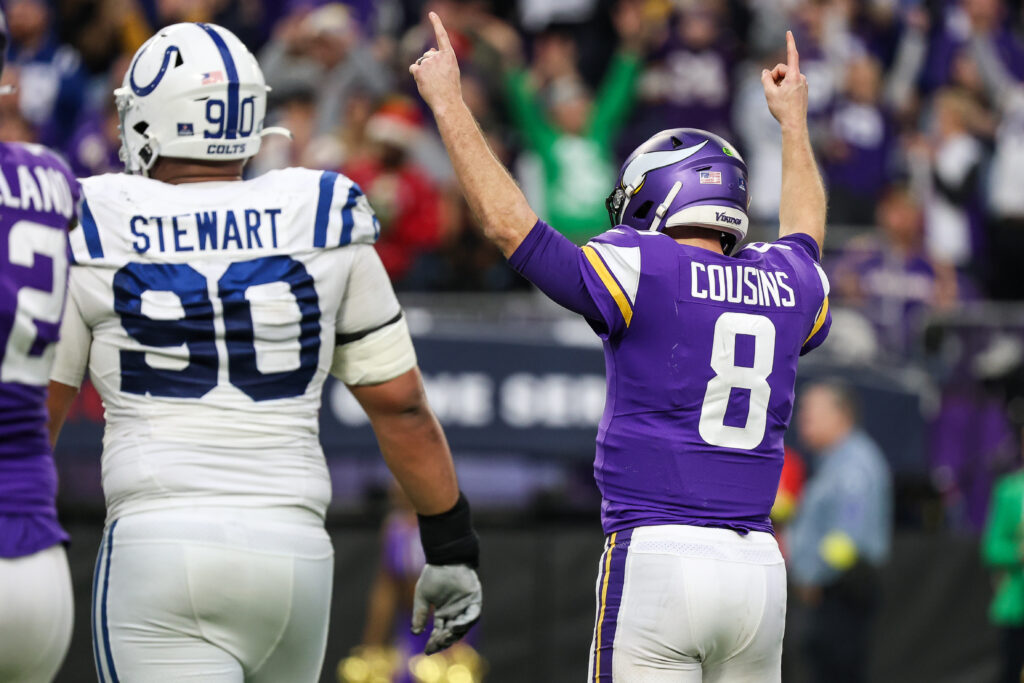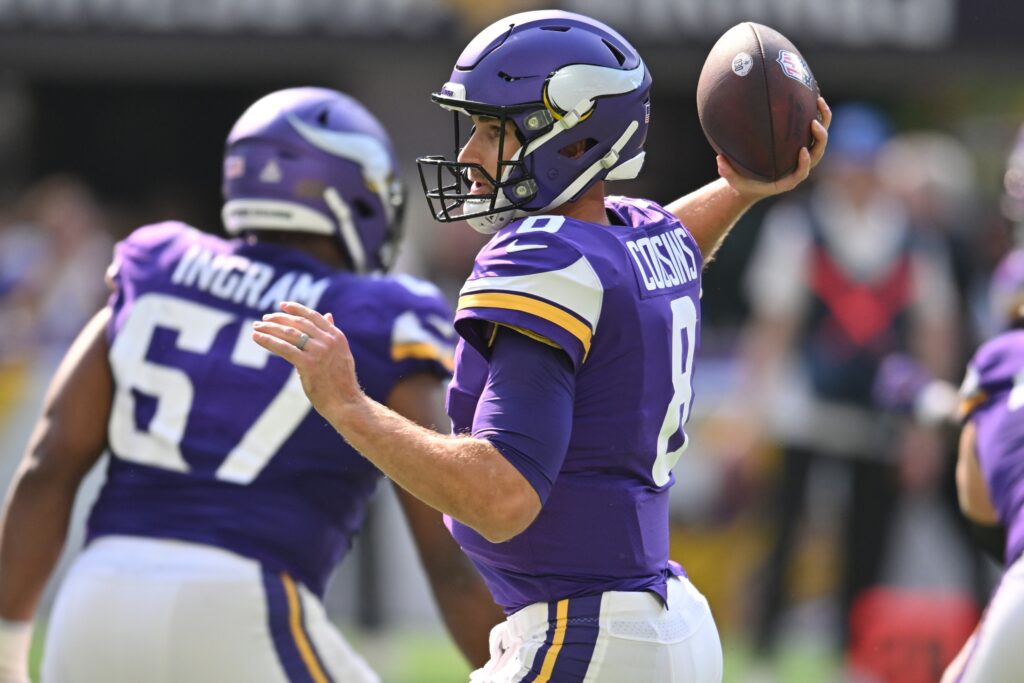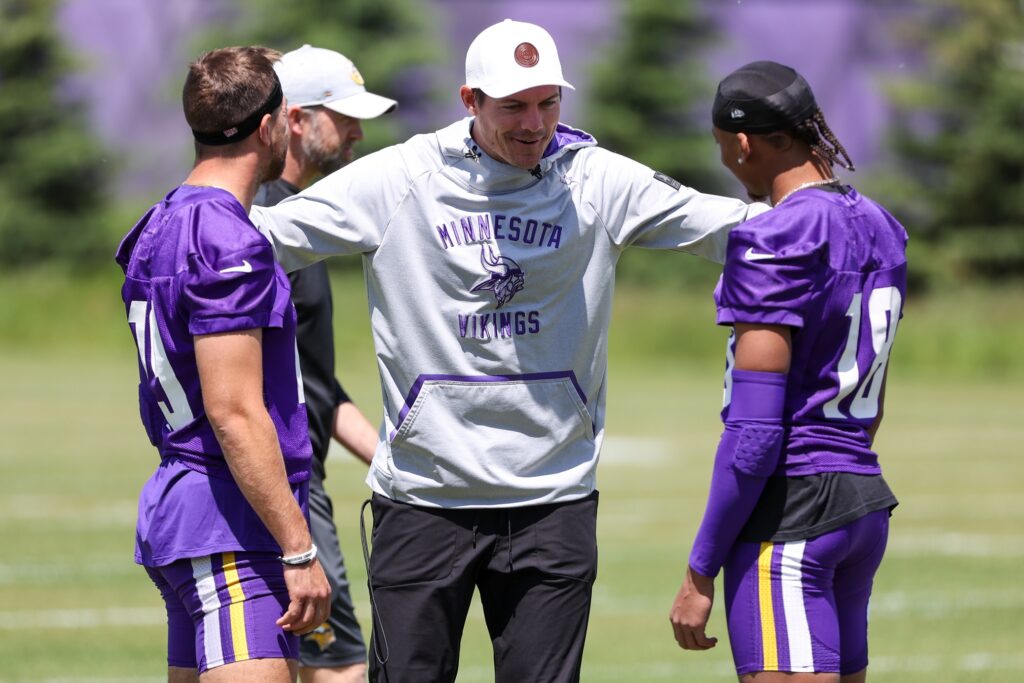It’s been a strange year for Kirk Cousins, statistically speaking.
Through 14 games, he’s sporting his lowest quarterback rating since becoming a starter, lowest yards per pass attempt, lowest QBR, third lowest PFF grade and he’s already registered the second most yardage lost to sacks in his career.
Yet Cousins has the second most game-winning drives in a single season in NFL history, the most wins as a starter and he’s put Justin Jefferson in line to potentially break the all-time receiving record. He’s played a more significant leadership role and has captured the belief of his head coach and locker room.
“I’ve been really proud of the way Kirk’s played and responded to … some tough circumstances and leading from the front and just being able to play in critical moments at such a high level,” head coach Kevin O’Connell said. “You don’t do a lot of things we’ve been able to do – coming from behind and doing some of those things – without a guy like Kirk playing quarterback.”
While his record of comebacks is nearly unprecedented — and his most recent high-wire act against the Colts is literally unprecedented — we have seen quarterbacks have similar season in recent years in which their efficiency was not as high as you’d expect from a winning QB but they found ways to lead their teams to victory. Let’s have a look at the most comparable QBs to Cousins’ 2022 over the last 10 seasons…
Method for finding comparables: Quarterbacks who won 11+ games and had similar yards per pass attempt when adjusted for sacks and interceptions, plus other factors added in like game-winning drives and circumstances. Cousins Adjusted Net Yards per Attempt is currently sits at 6.01, the seventh lowest among QBs with 11+ wins since 2013.
2021 Ryan Tannehill
Record: 12-5
ANY/A: 5.53
Similarities:
After putting up huge efficiency numbers in 2019 and 2020 that saw Tannehill rank among the NFL’s best in traditional rating, QBR and PFF grade, the 2021 season was much more of a grind for the Titans’ quarterback. He threw a high number of interceptions (14) in comparison to previous years and got sacked 48 times (Cousins is currently at 40) and threw less than 10% of his passes more than 20 yards downfield (Cousins sits at 9.4%). Tannehill didn’t get a lot of help from the screen passing game and he leaned heavily on his No. 1 receiver, AJ Brown. Both QBs were/are among the most pressured in the NFL and each produced ratings below 80 when under duress.
He didn’t have a lifetime’s worth of comebacks like Cousins has but Tannehill led four game-winning drives and was clutch in big spots, leading the Titans to top 10 rankings in third down, fourth down and red zone percentage.
Differences:
Tannehill had more of an uphill climb dealing with injuries around him. Derrick Henry only played eight games, AJ Brown missed four games and their major offseason acquisition Julio Jones only added 34 catches in 10 contests. The Titans’ defense was much more reliable than Minnesota’s, ranking sixth in points allowed.
The Vikings also asked less of Tannehill than Cousins. The Titans’ QB only averaged 220 yards passing per game versus 272 for Cousins.
2020 Ben Roethlisberger
Record: 12-3
ANY/A: 6.27
Similarities:
The future Hall of Famer had one last act in 2020, leading the Steelers to a division title while hucking the pigskin around 608 times. Big Ben’s 2021 season saw him throw quick-passing darts to move the Steelers’ offense, which resulted in his yards per pass attempt sitting at a 1990s-ish 6.3 YPA but his yards per completion (9.5) was somewhat close to Cousins’ present mark (10.8). As usual, Ben found ways to win games at the end, scoring four game-winning drives. Though, like Cousins, ESPN’s QBR metrics were not impressed. Cousins presently ranks 19th and Roethlisberger finished 22nd.
The 2020 Steelers received similar skepticism as the 2022 Vikings. They were only a 10-win team by Expected W-L and ranked 22nd in percentage of drives in which they produced points (the Vikings are currently 17th).
Differences:
Ben’s adjusted yards per attempt is nearly identical but the way in which each QB got there is not. Roethlisberger did so by avoiding sacks. He was only taken down in the backfield 13 times and was the least pressured QB in the NFL due to ranking No. 1 in snap-to-throw time. Like Tannehill, Roethlisberger was the beneficiary of a great defense. The Steelers were third in points allowed and third best against the pass.
2016 Derek Carr
Record: 12-3
ANY/A: 7.20
Similarities:
Because Carr did not take many sacks, his ANY/A is higher than Cousins but there are plenty of areas that match up from Carr’s winningest season. He produced seven game-winning drives and only gained 7.0 per pass attempt (not adjusted). The Raiders’ Expected W-L indicated they were closer to a 9-7 team, in part because of their struggling defense, which finished 20th in points allowed and 26th in yards allowed. Nine of their wins came within one score. Carr had a very good duo of top receivers in Amari Cooper and Michael Crabtree, both of whom grabbed 80-plus passes.
Differences:
Carr was not supported by a running game and the Raiders finished with the fourth best pass blocking unit in the NFL by PFF, compared to the Vikings who are 21st.
2016 Eli Manning
Record: 11-5
ANY/A: 5.95
Similarities:
Eli’s reputation for finding ways to win took one last gasp in 2016 when he led six game-winning drives en route to an 11-win season. Manning had a nearly identical yards per completion mark (10.7 vs. 10.8) and was similarly asked to move the ball through the air with regularity (251 yards per game). The two-time champ was blessed with one of the world’s greatest receivers in Odell Beckham Jr., who caught 101 passes for 1,367 yards that year.
Differences:
Manning was much more apt to make mistakes than Cousins. The Giants’ QB had the second highest rate of turnover-worthy plays in the NFL in ‘16 despite the ninth lowest average depth of target. Overall the Vikings’ offense was much more effective with New York ranking 26th in points. The G-Men had a horrendous running game, averaging just 3.5 yards per carry. Their defense was as good as it gets, finishing second in points allowed.
2014 Matthew Stafford
Record: 11-5
ANY/A: 6.03
Similarities:
You would think Stafford’s 2016 in which he led eight game-winning drives would be most like Cousins’ 2022 but his 2014 season is closer in terms of efficiency and usage. The Lions put a lot on Stafford’s plate, asking him to throw 602 times and with an average of 266 yards passing per game. He was similarly sacked 45 times and led five game-winning drives. At that point in Calvin Johnson’s career, he was closer to the No. 2 receiver with a young budding superstar in Golden Tate, who caught 99 passes for 1,331 yards. The Lions also out-performed their Expected W-L and won six one-score games.
Normally Stafford is considered a downfield passer but he only gained 7.1 non-adjusted YPA and surprisingly had the 11th lowest average depth of target, throwing over 20 yards downfield on just 10.5% of his passes.
Differences:
Stafford’s running games in Detroit were historically putrid and 2014 was no different. They only gained 1,422 at 3.6 yards per carry. As has been the case with many of the other comparable QBs, Stafford was helped by great defense (for once). The Lions allowed the third fewest points in the NFL in 2014.
2013 Tom Brady
Record: 12-4
ANY/A: 6.13
Similarities:
That’s right. Tom Brady. In what was a down year from a traditional statistics perspective, Brady pulled off five game-winning drives and won seven one-score games. The GOAT was sacked 40 times and threw 628 passes and averaged a nearly identical 271 yards per game. The Patriots were surprisingly so-so on defense in ‘13, allowing the 26th most yards. Brady also leaned heavily on Julian Edelman (105 catches) because Rob Gronkowski only played in seven games. Brady was assisted by a quality run game that landed ninth in yards.
Differences:
The Patriots still somehow ranked third in the NFL in total points and were fourth in scoring percentage. Brady’s ability to sustain drives was in peak form, ranking sixth in plays per drive, whereas the Vikings have struggled with three-and-outs, sitting 26th in plays per drive.
2013 Alex Smith
Record: 11-4
ANY/A: 5.94
Similarities:
There were three different Alex Smith seasons that were comparable to 2022 Cousins. He was sacked often, completed short passes (10.8 yards per completion), didn’t impress the QBR metric (23rd) and yet led the sixth best scoring offense in the NFL (Vikings are eighth). Neither team exceled on third down or produced points on drives consistently but both ranked top 10 in the red zone and did a good job of avoiding turnovers.
Differences:
Smith didn’t need the clutch gene to win 11 games. He only had one fourth-quarter comeback. He also didn’t have anywhere near a Justin Jefferson-type receiver. The 2013 Chiefs’ top pass catcher was Jamaal Charles. Kansas City did not lean on Smith as heavily as the Vikings had this year (221 yards passing per game) and the Chiefs’ defense ranked fifth in points allowed.
Conclusions
Adjusted Net Yards per Attempt can be a very telling stat about a quarterback’s efficiency and a team’s strength when it comes to the postseason. The top 10 since 2013 is made up of three Patrick Mahomes seasons, an MVP Matt Ryan, Peyton Manning, Tom Brady, Aaron Rodgers and 2015 Carson Palmer. Quarterbacks whose numbers are comparable to Cousins have been able to thrive in the regular season but haven’t often gone deep in the postseason, even if they are destined for the Hall of Fame like Brady or Roethlisberger.
The difference is that those QBs don’t have three more games remaining and the Vikings do. Cousins’ numbers have ballooned over the last two weeks in monster performances versus Detroit and Indy, in part because receivers other than Justin Jefferson have gotten involved and the screen game got rolling. Tight end TJ Hockenson has added another dimension to the mix as well.
The lowest ANY/A to reach the Super Bowl was Colin Kaepernick at 6.65 in 2013. Russell Wilson at 6.72 in 2014 is the only other QB below 7.0. So the Vikings have something to strive for in terms of passing efficiency — though being the outlier this year wouldn’t be any different from the norm.
Additional notes
— Garrett Bradbury missed practice for the second straight day with a neck injury, suggesting that Austin Schlottmann is likely to start versus the Giants.
— Ed Donatell said the team was still deciding whether they would stick with Duke Shelley at starting cornerback after a strong performance vs. the Colts. Cam Dantzler was on the injury report as limited in practice with an ankle injury.
— Justin Jefferson is either into basketball history or he watched the “The Last Dance.” In regard to hits he’s been taking lately, he said: “It’s just like Michael Jordan and the Detroit Pistons. They try to take out the best player, try to put as much physical abuse that they can on him. I kind of feel that way.” Jefferson said the hit he took from Stephon Gilmore was dirty with the way he rose up to hit him in the head.
— OC Wes Phillips didn’t put all the blame on his rookie right guard in explaining why he’s stepped on Cousins’ foot several times this year. “There’s a combination sometimes. I think earlier this year he was stepping a little too far down. Sometimes it’s the split. Then sometimes it’s the QB’s footwork as well.”
A very special moment today when Coach O'Connell delivered the news that @KirkCousins8, @JJettas2, @TheeHOCK8, @zadariussmith and @AndrewDePaola have been selected to the Pro Bowl Games. pic.twitter.com/ANxDsHop60
— Minnesota Vikings (@Vikings) December 22, 2022
Related: Justin Jefferson, Kirk Cousins among 5 Vikings selected for 2023 Pro Bowl










